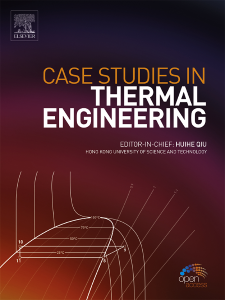Enhanced flow boiling heat transfer with three-section sudden expansion microchannels
IF 6.4
2区 工程技术
Q1 THERMODYNAMICS
引用次数: 0
Abstract
In this study, a three-section sudden expansion microchannels (TSE-MCs) heat sink was proposed to stabilize the flow boiling and improve the thermal performance of the heat sink exposed to high-heat-flux scenarios. The structural effect of newly designed TSE-MC and operating conditions on the heat transfer coefficient (HTC), pressure drop penalty, and flow instability were experimentally investigated and contrasted with continuous straight microchannels (CS-MCs). The experiments were performed at a saturation temperature of 35.5 °C, the mass flux ranging from 468–1033 kg/m2 s, and the heat flux up to ∼132 W/cm2. A comparative analysis based on the experimental results was conducted. Compared to CS-MCs, the nucleate boiling in TSE-MCs was initiated in advance with 0.2–1.2 °C reduction of wall superheat. The maximum HTCs at four mass fluxes, which was up to 62784 W/m2 K, were enhanced by 18.9–23.6 %. The uniformity of wall temperature was improved and the average wall temperature was reduced. HTCs and visualized results indicated that the dominant mechanism for heat transfer in TSE-MCs was nucleate boiling. Meanwhile, the pressure drop in TSE-MCs was slightly reduced, and pressure drop oscillations were greatly suppressed. The flow reversal in the inlet plenum was completely eradicated, and the performance evaluation criterion (PEC) of TSE-MC outperformed that of CS-MCs and was improved by 79.81 %–86.25 %. Overall, the present work demonstrates the great advantages of the newly proposed TSE-MCs, it offers a reference for the design of microchannel heat sinks for the real high heat flux dissipation applications.
利用三段式骤然膨胀微通道强化流动沸腾传热
本研究提出了一种三节骤然膨胀微通道(TSE-MCs)散热器,以稳定流体沸腾并改善散热器在高热流情况下的热性能。实验研究了新设计的 TSE-MC 结构和工作条件对传热系数 (HTC)、压降损失和流动不稳定性的影响,并将其与连续直管微通道 (CS-MC) 进行了对比。实验的饱和温度为 35.5 °C,质量流量范围为 468-1033 kg/m2 s,热流量高达 ∼ 132 W/cm2。根据实验结果进行了对比分析。与 CS-MCs 相比,TSE-MCs 中的成核沸腾提前开始,壁面过热度降低了 0.2-1.2 °C。四种质量通量下的最大 HTCs(高达 62784 W/m2 K)提高了 18.9-23.6%。壁温的均匀性得到改善,平均壁温降低。HTCs 和可视化结果表明,TSE-MCs 的主要传热机制是核沸腾。同时,TSE-MCs 中的压降略有减小,压降振荡被大大抑制。TSE-MC 的性能评价标准(PEC)优于 CS-MC,提高了 79.81 %-86.25 %。总之,本研究成果展示了新提出的 TSE-MC 的巨大优势,为实际高热流量散热应用中的微通道散热器设计提供了参考。
本文章由计算机程序翻译,如有差异,请以英文原文为准。
求助全文
约1分钟内获得全文
求助全文
来源期刊

Case Studies in Thermal Engineering
Chemical Engineering-Fluid Flow and Transfer Processes
CiteScore
8.60
自引率
11.80%
发文量
812
审稿时长
76 days
期刊介绍:
Case Studies in Thermal Engineering provides a forum for the rapid publication of short, structured Case Studies in Thermal Engineering and related Short Communications. It provides an essential compendium of case studies for researchers and practitioners in the field of thermal engineering and others who are interested in aspects of thermal engineering cases that could affect other engineering processes. The journal not only publishes new and novel case studies, but also provides a forum for the publication of high quality descriptions of classic thermal engineering problems. The scope of the journal includes case studies of thermal engineering problems in components, devices and systems using existing experimental and numerical techniques in the areas of mechanical, aerospace, chemical, medical, thermal management for electronics, heat exchangers, regeneration, solar thermal energy, thermal storage, building energy conservation, and power generation. Case studies of thermal problems in other areas will also be considered.
 求助内容:
求助内容: 应助结果提醒方式:
应助结果提醒方式:


